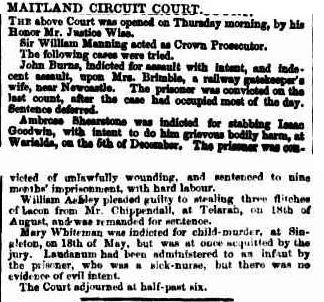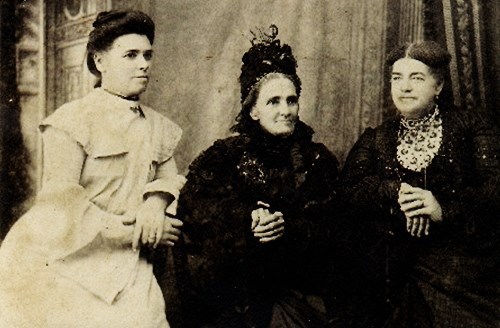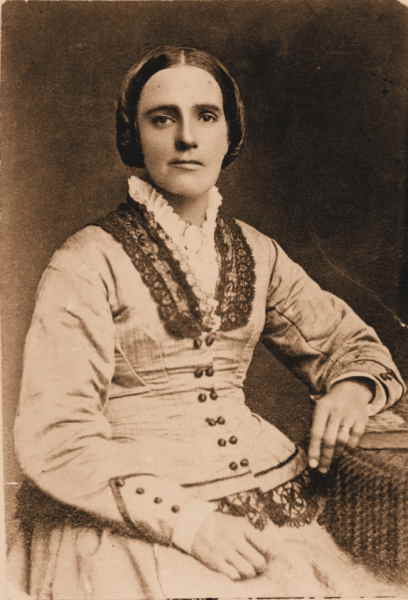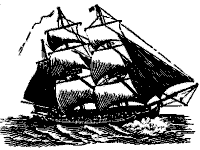After the birth of little Mary Ann the old routine set in with Edward visiting Mary whenever he wanted, and supplying paltry support for her and the children. He had told her it was impossible to leave Matilda until she could at least take the children with her when she went.
Mary had lost her hope of becoming Edwards’s wife, and her life became a little toxic. On the 9th March 1862 Mary was involved in a very unseemly incident with a neighbour. The Maitland Mercury & Hunter River Advertiser carried a story relating to the event as follows:
ASSAULT -Margaret Love was charged with this offence by Mary Whiteman, who deposed I reside in Hunter street Singleton , the information read is true On last Saturday week, the 1st instant, a Mrs. Love (the defendant) came into my house and asked what I was doing in her house at one o dock the previous night. I denied having been in her house. She thereupon called me a b- : w- , and struck me with her fist on the shoulder. She also threw a plate at me, which struck against the wall and broke. She then took up a table knife and it stuck in the wall also; she also said she would have my life. The defendant has threatened me every day since. She has also thrown brickbats at my house during several nights -Sarah Palmer also heard some of the abusive language. For the defense: Elisabeth Watson deposed that on Saturday week last about 3o’clock, she heard Mary Whiteman say, ‘There’s that common Irish w-, I shall have satisfaction of her, -meaning the defendant -John Love deposed: I am defendant’s husband. Last Saturday week I was at home. I am positive I heard no conversation between my wife and complainant until about half past five o clock in the evening, when I heard Mary Whiteman say, “There’s that common Irish w-, I shall have satisfaction of her I can swear that my wife did not go out of her house until half past ten that morning. Both the complainant and defendant were ordered to be bound over to keep the peace for three months, on their own recognizances of £5 each, towards each other.
Then on Tuesday 20th May something truly awful happened – Mary was indicted for the manslaughter of three week old Sarah Jane Palmer. The following appeared in The Maitland Mercury & Hunter River Advertiser on page 3: Please note that the name in the newspaper report was wrong. Mary Ann was the name of her own infant daughter.

Child Murder Charge – Mary Whiteman
SINGLETON.
Monday, 5.10 p.m.
At an inquest held on the body of Mary Anne Palmer, three weeks old, before Dr. Glennie, to-day, the jury found Mary Whiteman guilty of administering poison to the child, which died yesterday from the effects of a dose of laudanum. She was committed on the coroner’s warrant, for manslaughter, for the Maitland Assizes.
The outcome of the trial was widely reported both at a local level and in other state newspapers. The following notice appeared locally in The Maitland Mercury & Hunter River General Advertiser on Saturday the 6th September, 1862.
CHILD MURDER.
Mary Whiteman was indicted for that she did, on the 18th May, at Singleton, kill and slay Sarah Jane Palmer. Mr. Ellis appeared for the prisoner, attorney Mr. Briggs. The following witnesses were called for the prosecution – Sarah Palmer, Dr Glennie, Dr F Calov, and Agnes Morris.
Mrs. Palmer, a young married woman, was confined in April, at Singleton and was assisted for several weeks after by the prisoner, who on several occasions administered to the infant a peculiar mixture containing a small quantity of laudanum. On the morning of Sunday the 18th May, the child appeared well, but restless. The mother told prisoner to give it some castor oil and peppermint. Prisoner mixed the medicine with some stuff out of a bottle of her own, which she had previously given to the child, and it began, soon after it had got it, to show signs of convulsions and to turn black in the face. Two or three other women were present, and the infant had three doses of castor oil, an emetic, some magnesia, peppermint, and brandy and water, administered to it, but it died in ten hours after it had the prisoner’s mixture. A small phial was produced, containing the mixture, of which a part had been given to the child, but there was no analytical evidence as to what it was. A written statement of the prisoner’s was read, that she had mixed a very small quantity of laudanum, with oil for the child. Medical evidence failed to show what quantity of laudanum might safely be given to a child in a dose, one drop being considered sufficient in some cases to kill. It appears the prisoner did not give any directions as to what quantity of the mixture should be given to the child. It was stated that castor oil would not cause the coma and stertorous breathing which the infant exhibited on the afternoon before death; and that the livid appearance of the body, the compression of the lungs, and the emptiness of the heart and stomach, indicated that the child died of the effects of laudanum. The child was three weeks and four days old at its death. No malicious feeling was known to exist towards the Palmers on the part of prisoner. Mr. Ellis addressed the Jury for the defense, and his Honor summed up.
The Jury immediately returned a verdict of not guilty and the prisoner was disMrs. Palmer, a young married woman, was confined in April, at Singleton and was assisted for several weeks after by the prisoner, who on several occasions administered to the infant a peculiar mixture containing a small quantity of laudanum. On the morning of Sunday the 18th May, the child appeared well, but restless. The mother told prisoner to give it some castor oil and peppermint. Prisoner mixed the medicine with some stuff out of a bottle of her own, which she had previously given to the child, and it began, soon after it had got it, to show signs of convulsions and to turn black in the face. Two or three other women were present, and the infant had three doses of castor oil, an emetic, some magnesia, peppermint, and brandy and water, administered to it, but it died in ten hours after it had the prisoner’s mixture. A small phial was produced, containing the mixture, of which a part had been given to the child, but there was no analytical evidence as to what it was. A written statement of the prisoner’s was read, that she had mixed a very small quantity of laudanum, with oil for the child. Medical evidence failed to show what quantity of laudanum might safely be given to a child in a dose, one drop being considered sufficient in some cases to kill. It appears the prisoner did not give any directions as to what quantity of the mixture should be given to the child. It was stated that castor oil would not cause the coma and stertorous breathing which the infant exhibited on the afternoon before death; and that the livid appearance of the body, the compression of the lungs, and the emptiness of the heart and stomach, indicated that the child died of the effects of laudanum. The child was three weeks and four days old at its death. No malicious feeling was known to exist towards the Palmers on charged – his Honor cautioning her as to the use of dangerous medicines.
Sources:
DISTRICT NEWS. (1862, March 13). The Maitland Mercury and Hunter River General Advertiser (NSW : 1843 – 1893), p. 3. Retrieved July 19, 2015, from http://nla.gov.au/nla.news-article18687116











You must be logged in to post a comment.